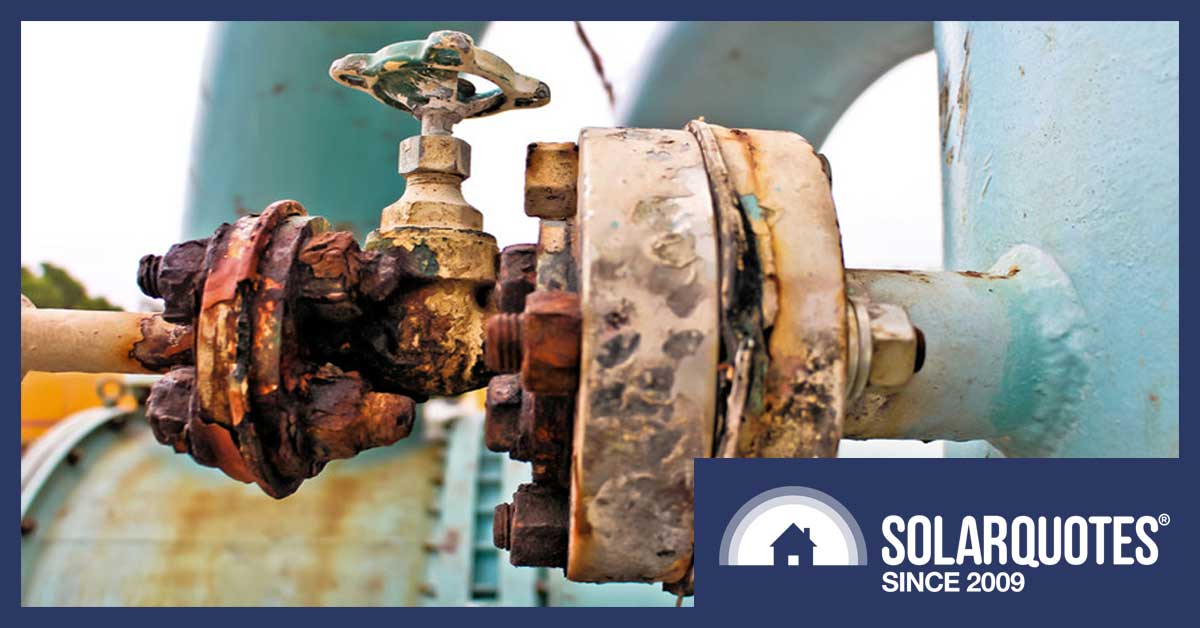
Solar Power Proves Far More Reliable Than Coal Power During Record Breaking Heatwave
As I’m sure you’re aware, South Australia and the eastern states were hit by a short but intense heatwave last week. In Adelaide temperatures hit 46.6 degrees on Thursday. A sweaty record. It was almost unbearable. Or at least I think it was unbearable. I’m not sure because I passed out at about 10 in the morning and didn’t regain consciousness until after nightfall.
But on the electricity supply side of things, despite the following facts:
- It has never been hotter1
- There have never been more South Australians
- There have never been more air conditioners, and…
- South Australians have never been fatter2
…the state did not suffer from blackouts due to a lack of power. Instead, around 60,000 South Australians suffered blackouts late at night due to blown fuses in an electrical substation. This is not a good thing, but it’s a separate problem from there not being enough power to meet demand.
It was Victoria that was unable to squeeze enough crackling sizzle juice through its electropipes to keep everyone’s air conditioners going. This was because around 40% of that state’s coal generating capacity was out of action when it was needed most. As a result, around 200,000 people suffered rolling blackouts on Friday because of their dependence on unreliable, aging, coal power stations.
Around 3% of the state’s population were affected, which isn’t too bad historically speaking. It’s not good, but there have been far worse outages in the past. But given the Coalition’s love affair with coal I think it is important to be very clear it was the unreliability of coal power that resulted in the blackouts, while throughout the heatwave solar supplied power in a reliable and predictable way from just before sun up to just after sun down. This included when demand for electricity was at it’s highest.
Coal Power — And Gas — Failed The Nation
During the heatwave gigawatts of coal capacity were out of action when the grid was desperate for power. A unit at Victoria’s brown coal Loy Yang A Power Station went out of action last Tuesday afternoon due to a tube leak. (My father had one of those — very nasty.) Capacity was also down for maintenance at Victoria’s brown coal Yallourn Power Station.3
Rather than take the effort to actually look up how much coal capacity was missing in action myself I’m just going to post a copy of what energy expert Simon Holmes à Court posted on Twitter on Friday:
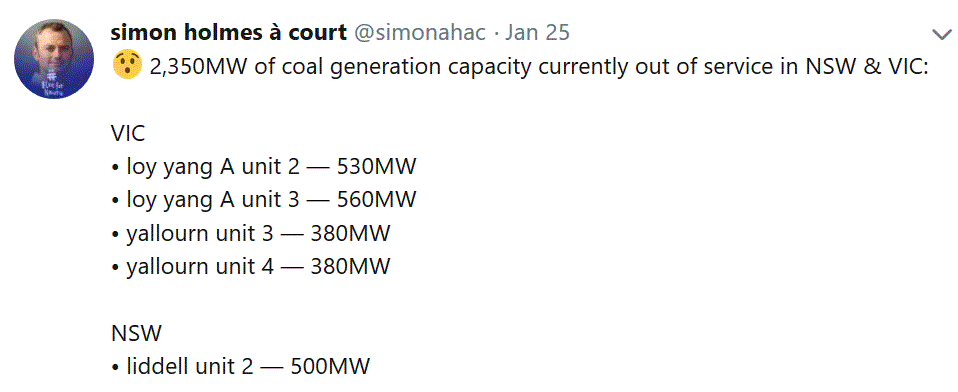
Image: His Twitter feed.
Simon is a pretty smart cookie but I’ve never mentioned him before because I could never work out how to put the little mark above the “a” in his name. (Maybe I should feel embarrassed about admitting this, but I’m at peace with the fact my intellectual cookie crumbled long ago.)
The 1,850 megawatts of offline coal power in Victoria meant 40% of the state’s total coal capacity of 4,660 megawatts was down and out during a record breaking heatwave.
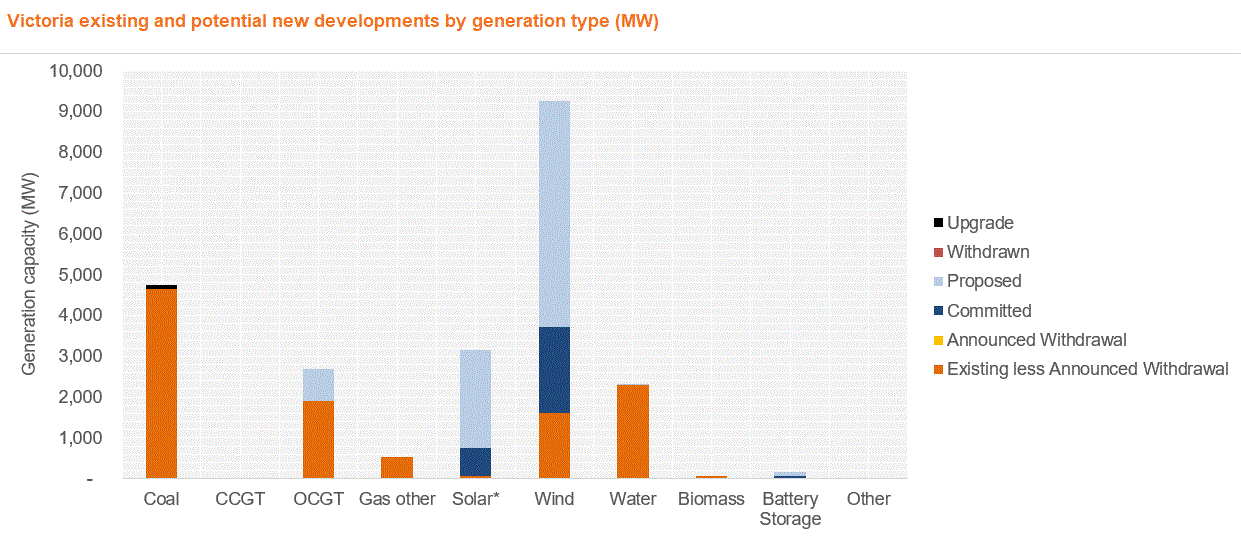
Graph showing Victoria’s current generating capacity, new capacity they have committed to building, and new capacity that has been seriously proposed . It does not include rooftop solar. Note it also doesn’t include any new coal power stations the Coalition says they want to built as they are not serious proposals. (Image: AEMO)
Gas Didn’t Do Well Either
In addition to coal generation sooting itself during the heatwave, a major gas generator in NSW also piked. On the 17th, Wollongong’s 435 megawatt Tallawara Power Station shut down for repairs.
Solar Reliably Provided Power During Peak Demand
Throughout the heatwave solar reliably provided power from sunrise to sunset. While solar farms are a growing source of energy, the large bulk of Australia’s solar power comes from panels on the roofs of homes and businesses. This graph from the Australian PV institute shows how much of total electricity consumption rooftop solar provided in South Australia on Thursday:
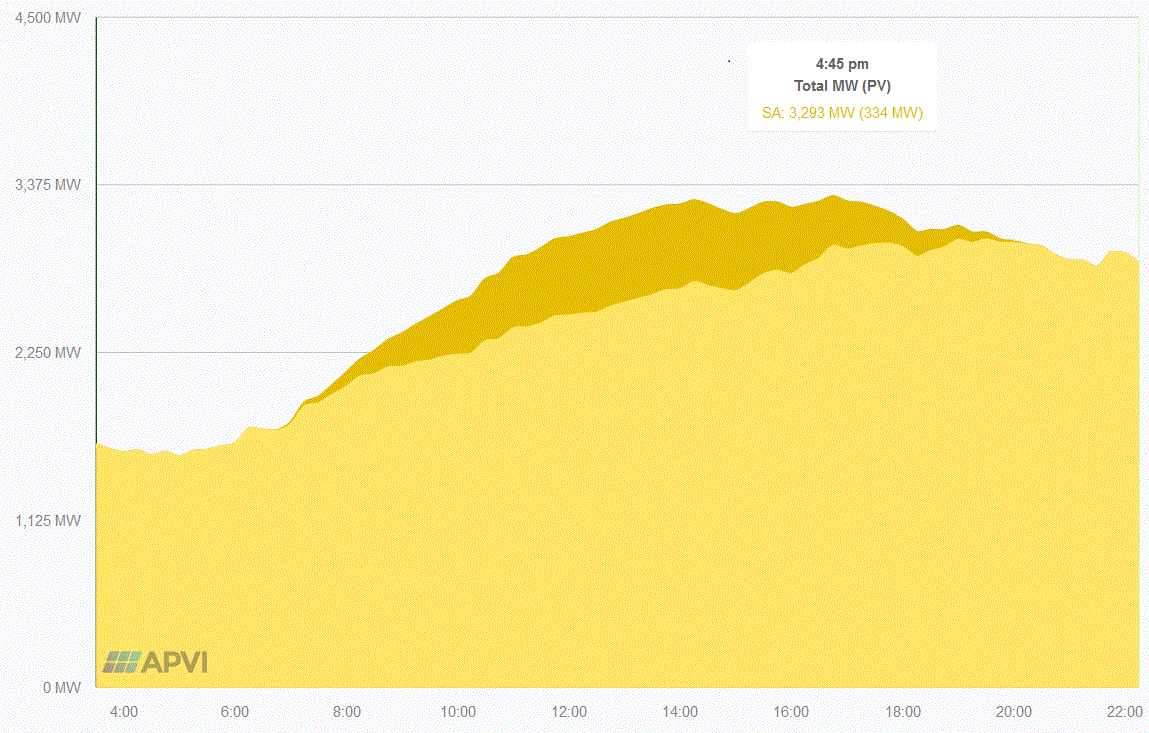
Total electricity consumption in South Australia during the record-breaking heatwave on Thursday the 24th of January 2019, with peak demand occurring at 4:45pm. (Image: Australian PV Institute)
Rooftop solar only provided a modest percentage of total electricity use. But when demand for electricity was at its highest at 4:45 in the afternoon, 10.1% of that total (334 MW) was being supplied by rooftop solar.
Earlier, at 2:15, total demand was 0.8% lower and 16.8% (550 MW) was rooftop solar. This is more power than South Australia’s Northern Power Station could produce before it closed in 2016.

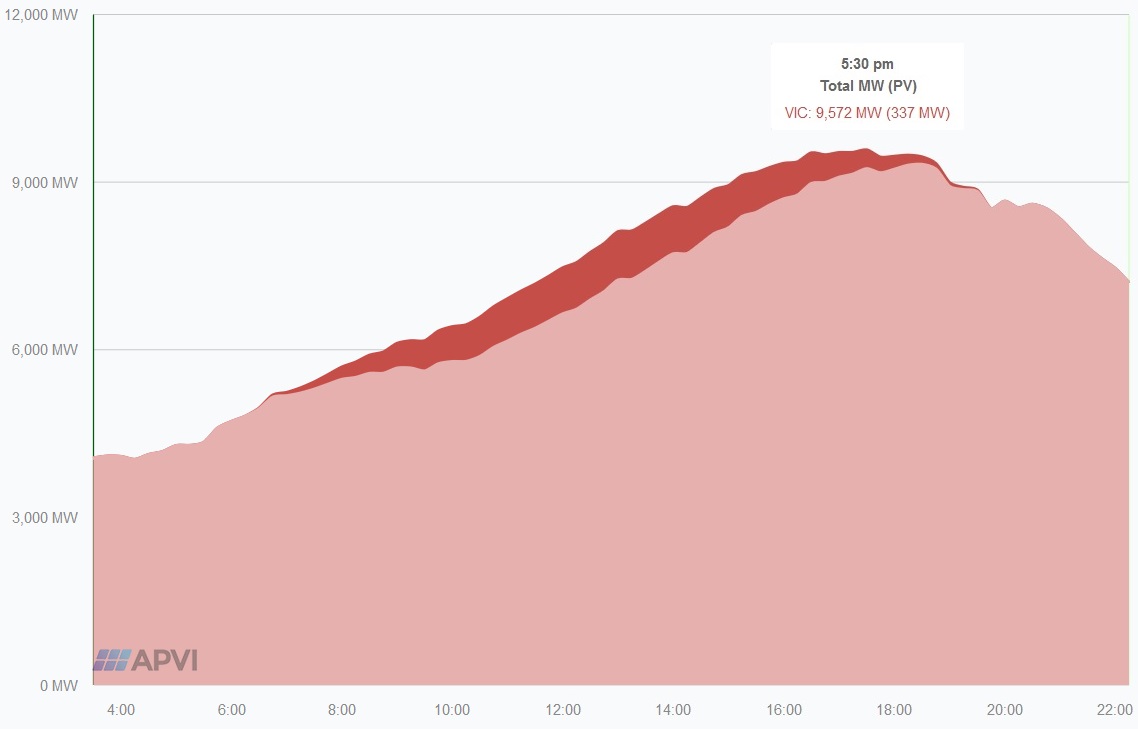
Total electricity consumption in Victoria on Thursday the 24th of January 2019, with peak demand occurring at 5:30pm. (Image: Australian PV Institute)
On Friday, when Victoria had its rolling blackouts, rooftop solar gave an even bigger contribution, supplying 8% of total demand at 11:30am. Peak demand was higher than the day before. It also occurred earlier. This was mostly due to temperatures falling, but the rolling blackouts also contributed.
The New Emergency Reserve Scheme Was Used
Because Australia’s coal power stations are so unreliable an expensive new scheme known as Reliability And Emergency Reserve Trader or RERT was created last year to reduce blackouts when coal power craps out. South Australia’s new diesel generators are part of the RERT and were working during the heatwave to help keep Victoria going.
Why Solar Power Is More Reliable Than Coal
Australia’s aging coal power stations average over 30 years old, while Victoria’s remaining two brown coal generators are particularly decrepit:
- The massive 3,300 megawatt Loy Yang A and B are 34 years old.
- The 1,480 megawatt Yallourn Power Station has units ranging from 37 to 46 years old.
The ancient power stations can’t be relied upon as they are simply getting worn out. By it’s very nature coal power involves the risk of fires and burst pipes.
Solar is more reliable than coal because it has no moving parts.4 While a solar farm could have a large inverter fail, because they have multiple units this is not likely to take much production offline. A solar farm could suffer a transmission failure, but this is true of any utility scale generation.
Rooftop solar is distributed and produces power where it’s consumed. On one hand this makes it the most reliable energy source as it can still supply power even if transmission lines fail. On the other hand, if problems with the grid are serious enough for blackouts to occur then most rooftop solar production in blacked out areas will be lost. This is because most rooftop solar systems shut down when the grid is out as a safety precaution. Only a tiny number of households have hybrid inverters or battery systems capable of full backup that let them to continue to use rooftop solar during a blackout.
Variable Does Not Mean Unreliable
You may be wondering why I’m saying solar power is reliable when it doesn’t work at night and clouds can drift overhead and reduce its output. This is because while the output of solar is variable, we can accurately predict it in advance and this makes it reliable.
Coal power is like that friend who is always saying they will show up but often pikes and lets you down without notice. Solar is more like a friend who doesn’t always say they’ll be there, but when he says he will you can count on him. He’s not willing to rock up at midnight for you, but if he says he’ll do something his word is as good as gold. At the very worst he’ll be a little less energetic than you expected him to be5.
If it’s clear or overcast it’s easy to predict what solar output will be days or even weeks ahead. Patchy cloud makes it difficult to predict what the output of any one solar power system will be, as more clouds may drift over one rooftop than another, but solar capacity is distributed over a wide area so it’s easy to predict what its output will be in aggregate.
Solar can be relied on to have high output during heatwaves because clear skies and hot weather go together.6 Heatwaves also occur in summer when the days are longer.
Unfortunately, high temperatures reduce the output of solar power. A 15 degree increase in temperature from 30 degrees to 45 degrees will lower the output of a typical solar panel by around 6%. But this is more than offset by the lack of clouds and long days that go along with heatwaves. Coal and gas power also have their efficiency reduced by high temperatures. The effect is not large but does hurt output. Working out the efficiency drop is complicated as it depends on what kind of cooling is used.7
New Coal Power Stations May Not Be Much Better Than Current Ones
Australia is never going to build a new coal power station. Coal power is not cost competitive, it’s terrible for the environment, and horrible for people’s health. But if the Coalition got their ardent wish and build a new coal power station, don’t expect it to be much more reliable than the existing clapped out coal burners.
A study came out a few days ago called Suboptimal Subcritical that looked at Australia’s most moderncoal power plant8, the supercritical Kogan Creek Power Station in Queensland which came online in 2009. The study concluded that its breakdowns:
- Occur often
- Are the biggest in the NEM
- Have contributed to price spikes, and…
- Have caused frequency losses outside of the safe operating band — which means the coal power station broke down and suddenly stopped supplying power, which meant grid operators had to scramble to keep the grid stable.
The Coalition wants new coal capacity to be supercritical like at Kogan Creek. I don’t think they know what supercritical means, but they want it anyway. This means new coal power stations will be less reliable than solar power from day one.
The Chinese companies that are the world experts at building supercritical coal capacity — and which almost certainly would be hired to do the work — will have ironed out many of the bugs, but it’s still a risk. Even if these hypothetical new coal power stations have improved reliability, their complexity and combustible fuel means they’ll never approach the reliability of literally millions of solar power plants distributed across rooftops and fields.
Footnotes
- Yeah, sure, maybe it was hotter in the early Eocene or some other point when there wasn’t anyone around with a properly calibrated thermometer to check in the shade air temperature, but if I stop to qualify everything I write I’ll be here all day. I’m going to assume you can add in any qualifications you may require on your own with a crayon. ↩
- I refuse to comment on how much the state’s average weight went up by when I moved here. ↩
- Energy Australia, the owner of the plant, must have been kicking themselves over being unable to provide the power that was necessary to prevent blackouts because of the maintenance. I just hope the average of $3.38 per kilowatt-hour they were able to receive for electricity sold in Victoria on Thursday helps ease the pain I know they must be feeling deep in their hearts. ↩
- To be more precise, rooftop solar has no moving parts, apart from a fan in some inverters. Concentrating Solar Thermal has moving parts but isn’t providing power in Australia yet and most solar farms now mount their panels on trackers that follow the sun through the day. The trackers are a moving part that sometimes fails but they’re not likely to all fail at once or have a failure mode that involves exploding. ↩
- Wind power is like solar in that its output is predictable days or even weeks in advance. Solar forecasts can be slightly off and this was a contributing factor to a relatively small blackout in Adelaide in February 2017. ↩
- Unfortunately, wind power can’t be expected to have high output, as stiff breezes and heatwaves don’t normally go together. ↩
- Power stations that use ocean water for cooling are generally less affected by heatwaves than those that use air or Toowoomba waste water as the Millmerran Coal Power Station does. ↩
- Update 6th Feb: Kogan Creek is Australia’s most advanced coal power station, but the 416 MW coal Bluewaters Power Station using an older design, was commissioned in Western Australia in 2009. ↩

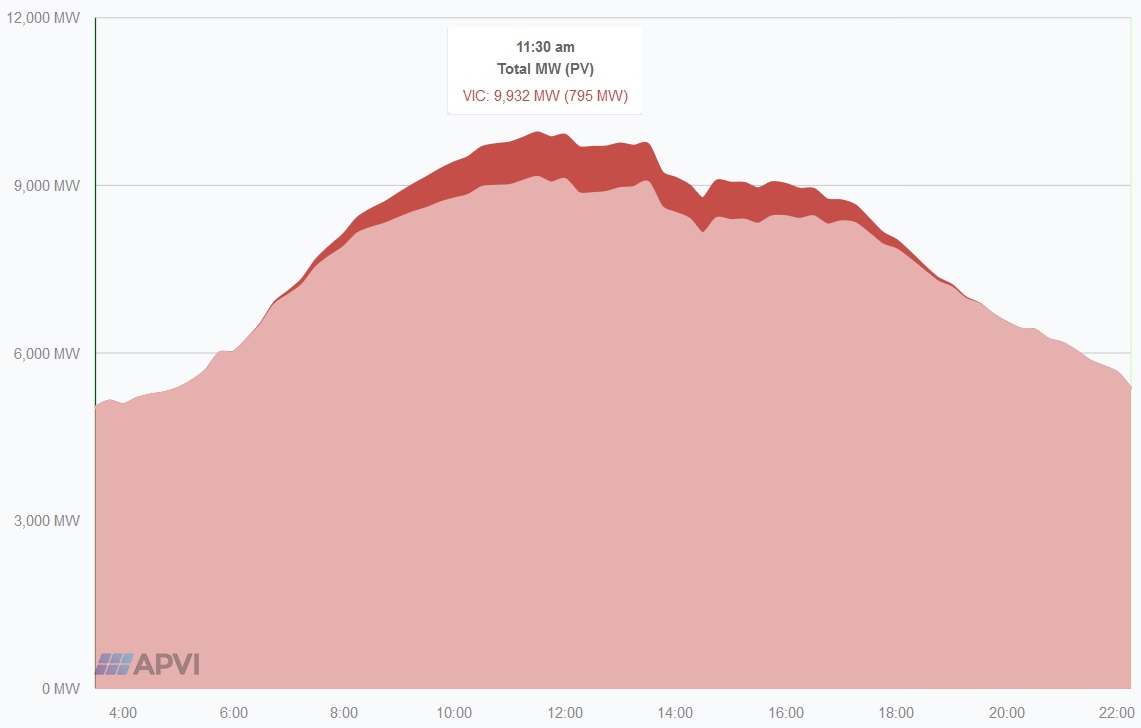
 RSS - Posts
RSS - Posts



Much like the time the grid tripped as it was designed to do when SA had the big blackout due to fallen transmission towers Not that that stopped Mal Barnaby Josh Kelly and co from getting it all wrong & blaming renewables. But to make matters worse they still repeat the same false dribble But Sco Mo knows better he comes to South Aus or more importantly Whyalla to heap praise upon the man who is revitalising the town with renewable energy & Jobs that Scotty the liar seeks to take credit for along with the current SA premier Pity it is all due to Jay
Of course when our existing solar & wind generators get to the age of current coal generators, I expect we will be in the same position we are now. Although with a sensible replacement policy it should not be a problem. Mind you, I’m still waiting for sensible to be a product of any government or supplier.
And the problems in Vic could have been mitigated – & perhaps eliminated – if such a strategy had been implemented over the last decade or two. Eg, by constructing a new coal (or nuclear) power station when it was economical to do so. Current situation – at least as regards electricity costs – reminds me of Enron in the US back at the turn of the century.
Solar and wind will never put the grid in the precarious position that large coal generators have. This is because if a 3 megawatt wind turbine or a one megawatt block of solar panels goes offline it’s trivial compared to the gigawatts that can be lost when a large coal power station trips.
Of course they will. On a cloudy windless day it doesn’t matter how many tiny power stations you have. Have a look at Open NEM and see how much power was being generated by dirty diesel in SA!
I’m not currently in a mood to repeat myself, so if you could read the article first and then get back to me if you have any questions, that would be great. Thanks.
Must be fairly lazy then. The issue is not that renewable energy is not a good thing just don’t over egg what it is capable of. It will reliably provide unreliable power. You have been very cute in your definition of reliability but this is not how reliable power is defined in the context of power supply. Reliable power is measured on how it provides power on a 24 hour 365 day basis and yes, coal power stations are becoming more unreliable on this definition and will continue to do so but are still more than twice as reliable os solar or wind.
On the hot day in SA only 35% of power came from renewable energy and the battery contributed 0.2%. SA had to employ diesel generators to ensure supply.https://www.dropbox.com/s/mhy676ttpc86lqf/Screenshot%202019-02-01%2010.38.13.png?dl=0
I guess cloudy heatwaves will be a big problem when we colonize Venus.
How does one get hold of a hybrid inverter? It bugs me that my solar panels will fail if here is a blackout.
Well I guess you could spend $10,000 on batteries and a lot on a Hybrid inverter plus the installation cost so that you will be covered for 1 or 2 days a year during power outages which are usually short depending where you are. It would be cheaper to to just make do and be pre-prepared for such situations:
1. Purchase a Gas cooker to cook and boil water for those times, order in a take-away meal.
2. Purchase a small UPS to keep your Modem running and a Laptop charged up or use a tablet. You could also purchase data for your mobile device and tether to it using your Laptop or other non xG device.
3. Use you car battery (plug into cig lighter or a utility socket) to charge or to run devices.
4. Purchase LED camping lights ($5 with batteries) to have on hand.
As for a fridge don’t keep opening it during an outage. I have never lost any frozen food to a power outage in 60 years. Only problem I have is me not closing the door fully!
If you have a good FiT then a battery is not going to be economically sustainable but if money is not the issue then go for it.
All very valid arguments, but battery backup will serve a great purpose everyday once the sun sets and not just on those 1 or 2 days of power failures. More cost effective now with some states coming to the party with subsidies. Added benefit for me is the warm and fuzzy feeling knowing I use the minimum power off the grid.
It’s all about using the right cross-breeding technique. There was a monk called Mendel who knew more about this than me.
Great article Ronald!
Hi Robyn
Our hybrid inverter comparison shows all hybrid inverters available in Australia that we have good information on:
https://www.solarquotes.com.au/battery-storage/hybrid-inverter-comparison/
If you want to have power during a blackout you will generally also need batteries. If you follow this link and answer the questions as best as you can we can put you in touch with installers willing to upgrade your system:
https://www.solarquotes.com.au/quote/quote1.php?feature=addbatteries
But if your goal is to get through blackouts it can be much cheaper to invest in a generator.
I’m glad Victorians are not as gullible as many of are here in SA are and kept Labor in power in Vic.
Thanks to the COALlition lies, and commercial radio stations that are heavily biased to the right (check to see who owns those stations) we ended up with a Liberal gov here in SA. Unfortunately even Jay Weatherill’s public chastising
of Fryburger over negativity and lies by the COALlition was not enough to keep Labor in power in SA.
Looks like Scomo will need to drag out his big lump of Coal again to preach to the converted to keep them on side.
Another serious problem with our coal-burning friends is that when you DO invite them to join the party, they take forever to get ready. Often so long that the party’s over before they’ve done their comb-over. On the other hand, batteries can be ready and at the front door in a flash.
Worst analogy ever 😉 Perhaps coal, when he does turn up, is the friend who trashes your houses and drinks all your beer.
I think the graphs indicate the scale of the problem. Just between South Australia and Victoria they were using close to 14GW of energy at peak demand. The total amount of installed Solar in Australia is approx. 10GW but of course it will never produce that at any one time – let’s be generous and say 7GW at peak but as you’ll notice from the graphs peak demand and peak solar production do not necessarily coincide. At 10pm at night the two states were still using 9.5GW and solar output would be close to zero (well whatever the west coast is still producing). So we better hope those ageing power stations keep working until the govt decides to get off their backsides and do something. At least back AEMO’s ISP and put the proper incentives in place to achieve that.
Coal is not intrinsically unreliable.
It used to give us the cheapest electricity in the world, with no blackout due to lack of supply.
But coal is no longer in general favor and generators are neglecting it.
They can make good profits from renewables with subsidies.
Like $14,500 MWh.
Now we have about the most expensive electricity in the world.
If Australians are happy with that, then fine, but don’t blame coal.
Jeff, I am an ancient, decrepit, husk of a human being and I can assure you we had blackouts in the past due to lack of supply. In all states. Western Australia even went through a period where they banned shopping centres from using escalators or air conditioning in an attempt to keep peak electricity consumption down.
OK fair enough, I am 55 and don’t really remember much about power shortages, but then again I don’t remember much in general now.
There is probably a lot more media frenzy with blackouts these days too.
Yes, especially by media that is so heavily biased to the right circulating their rubbish.
Why would you take out a power station for maintenance when they would have known it was going to be a really hot day and they also knew more people would have been running more aircon unless it was only for financial gain, we need a royal commission into these tools that run public services.
Because the power station is over three decades old and requires said maintenance to reduce the probability of failing more dramatically…!
I don’t know if said plant was undergoing major or minor maintenance but I do know from experience working with very large energy installations, some major maintenance campaigns need to be planned months or even years in advance so there could have been some degree of bad luck involved in the timing of the heatwave, particularly coinciding with unplanned outages at other plants.
Surely you’re not suggesting Our suppliers would adopt the Enron strategy: close down two (of 3) nuclear power plants for “maintenance” in California in the middle of winter, then buy at exorbitant rates from an Enron subsidiary in Nevada to Supply essential services. Allegedly.
thats rubbish i don’t remember having that many power outages on the past due to hot weather and I’m 70 . you can sprout all the figures ypu like , but i dont see solar or wind doing much more than running limit back up at this point in time. the only reason coal is not doing the job is lack of maintenence upgrades. and hello who’s in power in Victoria
Obviously dementia is preventing you from remembering power outages in the past. It has also escaped your mind that the Generators are all privately owned, thanks to Jeff Kennett, and current State Governments, of any pursuasion, have no influence over what maintenance or upgrades these private companies will spend their money on. They’re there for short-term monetary gain, not long-term public interest.
One thing that is forgotten here is that solar fails every day. I have worked in black coal fired power stations for over 30 yrs on both maintenance and operation so I don’t have to look up Wikapedia to find the answers.
In all the debate there is nothing that gives me any confidence that things will improve on the contrary they will get worse as the issue of base load has been ignored.
Origin has said they will take out 1600 Mw from the system in 2022 when they shut down Liddell but as they are vertically integrated it then give them the ability to manipulate the market. No different to what Telstra was doing before they were forced on the the NBN.
Coal fired power stations are complex pieces of machinery and with the selling of the generators there are two tried and true ways to give greater returns to share holder for any company, cut staff and cut maintenance. Companies don’t want to spend money on maintenance so reliability is the result.
We live in interesting times.
If you’re not going to read the article, don’t expect people to take your comment seriously.
You think we all forgot that the sun rises and sets?
Yes I did read it and some people have that perception.
OK.
Carry on.
Ronald – in the above article, is
”
Only a tiny number of households have hybrid inverters or battery systems capable of full backup that let them to continue to use rooftop solar during a blackout.
”
Can you clarify something for me, regarding this?
In a brochure for the Goodwe GW5048D-ES, from a year ago, it showed the backup mode as not allowing the photovoltaic panels to generate electricity during a grid outage, allowing power to come from only battery storage, but, in an instruction manual that I have just found for the inverter model, it shows the backup mode, as allowing power to come from both photovoltaic panels and battery storage, during a grid outage (which seems much more practical).
Has Goodwe changed the inverter design, or, is one of the two documents wrong?
That’s a good question. Looking online I found a person who said it charges their batteries when operating in off-grid mode but it takes a long time as even if there is plenty of solar surplus solar energy available the hybrid inverter will only start to charge the batteries at a very low rate and then slowly increases it. But if household consumption or a cloud interrupts the process it apparently starts again, making the batteries slow to charge. Presumably the larger your solar system the less of a problem this will be. Also if no one is at home during the day using electricity it should be less of a problem.
so what your saying is that private companies are in charge of maintenance of our utilities , so if their not making a profit they take their bat and ball and go home . and by the way before i was talking about the days long before privatization when some fool decided that would be a great idea and save us money. anyway i agree that coal cannot supply electricity forever and we will nerd another means but i just don’t think solar or wind is the complete answer at thos point in time. And where do we store the batteries
It’s not the complete answer atm but there are many different forms of renewable energy technology out there but until the federal government gets their act into gear for a network of different generators are used across Australia it’s not going to happen especially under this COALition lot.
As for storage of batteries what’s wrong with H2O? and ponds probably with far less maintenance involved. (it’s called pumped Hydro).
You are correct in your assumption as private companies only think of the dollar and how they can make more. I bet the state governments in power now are regretting the day they sold off the power assets as the voters will blame them for any outages and price increases.
I have no doubt that the likes of Hazlewood would be shut down but governments will look at the state as a whole and not put themselves in the position of suffering a voter backlash and make sure there was adequate generation to replace it.
We see the same with Liddell a case of stuff you I’m alright whereas governments would look at the state as a whole.
Queensland is an example. The labour government sold the railways at the beginning of a term in government and the opposition used that against them saying they can’t be trusted they sold the railways never telling the voters and won in a landslide, Come the next election the government went to the election with a proposal to sell the power assets and ports and lost in a landslide so privatising state assets are poison for governments now.
Mike,
You state:
“I bet the state governments in power now are regretting the day they sold off the power assets as the voters will blame them for any outages and price increases.”
I think the state political parties that were in government that were responsible for selling off state-owned power assets are hoping the voters have no idea who’s responsible for the current predicament or have short memories.
For example, the NSW Baird Coalition government sold the state-owned Vales Point power station in November 2015 to Sunset Power International for about $1 million – roughly the median price for a Sydney property.
The NSW Parliament Legislative Council Select Committee on Electricity Supply, Demand and Prices in NSW conducted a public hearing on 18 June 2018 where representatives of Delta Electricity, operators of NSW’s 1320 MW nameplate capacity Vales Point power station, were examined under oath. From the hearing transcript, on page 29:
“The Hon. ADAM SEARLE (Labor): Vales Point power station was sold for about $1 million. What is its current valuation?
Mr EVERETT (Managing Director, Delta): Its last value was around $720 million.
The Hon. ADAM SEARLE: It was a pretty good buy for you guys.
Mr EVERETT: For those that bought it, yes.
The Hon. ADAM SEARLE: As part of that arrangement, did the State have to guarantee that it would purchase a certain amount of the electricity generated?
Mr EVERETT: No.
The Hon. ADAM SEARLE: So you just sell it at large, to all customers.
Mr EVERETT: Yes.
The Hon. JOHN GRAHAM (Labor): How much did you make last year, selling electricity into the market?
Mr EVERETT: Last year it was in the order of $90 million profit.”
See: https://www.parliament.nsw.gov.au/lcdocs/transcripts/2069/Transcript%20%20-%2018%20June%202018%20-%20corrected.pdf
I think NSW citizens were soundly and undeniably diddled by the NSW Baird Coalition government on the Vales Point deal. I doubt whether most people are aware of this circumstance.
NSW state-owned 1000 MW Wallerawang and 1400 MW Mt Piper power stations were sold together to EnergyAustralia for $475 million in September 2013. Wallerawang promptly ceased generating in March 2014, without much fuss nationally. I think that only when Engie announced in November 2016 the closure of Victoria’s 1760 MW capacity Hazelwood in March 2017 did national attention begin focusing on electricity affordability and reliability.
2000 MW Liddell (announced retirement in 2022) and 2640 MW Bayswater (announced retirement in 2035) were sold together to AGL in September 2015. 2880 MW Eraring (probably closing in 2032) was sold to Origin.
The federal Abbott COALition government (sworn in on 18 September 2013, until Abbott was deposed by Turnbull on 14 September 2015) did not object to the NSW state-owned generator sell-off at that time. Now some COALition parliamentarians (including Tony Abbott MP) want tax-payers to forcibly buy-back ageing and increasingly unreliable Liddell.
The current NSW government apparently hasn’t spent any money on new electricity generation in NSW, yet it’s willing to spend about $1.5 to 2.2 billion (depending on who is talking) on knocking down two stadiums and rebuilding them – “world class” sporting facilities seem to be far more important to the NSW government than fixing an increasingly more unreliable and ageing NSW generator fleet.
Clearly IMO, NSW needs to be investing in ‘dispatchable’ generation utilising a mix of solutions examined and highlighted in a report prepared for the Australian Renewable Energy Agency (ARENA) titled “Comparison of Dispatchable Renewable Electricity Options: Technologies for an orderly transition”, published in October 2018. Fixing NSW’s electricity network will take longer than the duration of the next NSW parliamentary term.
See: https://arena.gov.au/projects/dispatchable-renewable-electricity-options/
yesteryear nobody thought to much about power , it was always there and cheap. as soon as it was privatized up went the cost and now it’s on everybodys mind . It appears that we have been deserted by our government a and its every person for themselves. what ever happens its going to cost the consumer a bucket load of money and make others very rich.
.
@geoffrey redmond
Every person for themselves is correct. If you can afford the outlay then a solar system without batteries will pay for itself quite quickly. My system I had installed in April 2017 has paid for itself by about 50% already. Maybe even faster if you use a lot of power in your house. You also need to be proactive in looking for the best plans and filtering out the BS they spin. They are there to make money for their share holders and don’t give a rat’s toss-bag about the public.
The folks in Townsville may need more than solar in the short-term (incl hospitals etc)
Pretty hard read there in both documents. It is a staggering cost of batteries refereed to in the Arena document. I heard the the generation was virtually given away in NSW and now I know for sure.
There is going to be no short term nor cheap solution to the mess that now exists and looks like getting worse as lead times are so long. Snowy pump storage like all pump storage while it is proven technology it is costly to build and it would be unlikely to build sizable system by the private sector.